Celebrating 100 years of Bauhaus
Eight things you should know about the Bauhaus
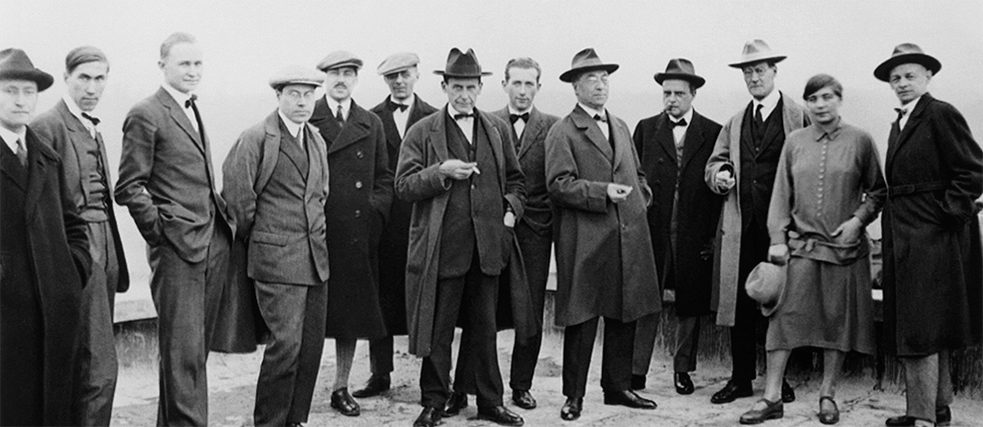
Minimalist design, simplicity and efficiency – how the Bauhaus aimed to change the way we live.
By Nadine Berghausen
Designing a social utopia
The Bauhaus art school was founded with a very ambitious objective: to create community through art. And this was no understatement either, as the Bauhaus dreamed of serving “new people” though its applied art. For the first director and founder of the Bauhaus, Walter Gropius, this involved a close synthesis of the different disciplines in arts and handcrafts. Gropius felt everyday objects must be redesigned to fit the production process, so that they could be manufactured quickly and inexpensively. This would make good design affordable in Germany again, at a time when the country’s economy had been decimated by the First World War.
The Bauhaus spirit
The concept itself sounds like a peaceful artists’ commune. Today we might imagine a famous graphic designer, an architect, a fashion designer, a DJ, an installation artist and a photographer all coming together at an remote art school where they pool their limited financial means to live, teach and develop ideas for a better society. But the reality in Weimar, Germany was anything but a harmonious community of creative minds working in concert. Painter Josef Albers recalled disagreement about everything: “When Wassily Kandinsky said yes, I said no, and when he said no, I said yes.” This artistic dissent was exactly what Gropius wanted for his school, for he felt it would further his objective: “the goal of the Bauhaus is not a style, system, dogma, canon, recipe or fashion. It will live as long as it does not depend on form, but continues to seek behind changing forms the fluidity of life itself.”
From a design revolution to architecture school
The first stage of the Bauhaus in the city of Weimar (1919-1925) was characterized by a sense of transformation and enthusiasm. Gropius strove to bundle ideas and build workshops. The Weimar period was a time of theoretical experimentation, before the Bauhaus moved to new premises in Dessau (1925-1932) and its second director Hannes Meyer began cutting costs. There was not enough money to sit around pondering basic colours and forms; the focus had to be on devising social buildings. Meyer spoke of a “proletarization” of the Bauhaus. Another move followed, and under the leadership of Ludwig Mies van der Rohe in Berlin (1932-1933), the movement broke with its founding principle of creating synergy effects between artistic disciplines. The Bauhaus ultimately evolved into a school of architecture.
![Group photo of Bauhaus masters in Dessau (1926) - [big] Group photo of Bauhaus masters in Dessau (1926): f. l. t. r: Josef Albers, Hinnerk Scheper, Georg Muche, László Moholy-Nagy, Herbert Bayer, Joost Schmidt, Walter Gropius, Marcel Breuer, Wassily Kandinsky, Paul Klee, Lyonel Feininger, Gunta Stölzl und Oskar Schlemmer.](/resources/files/jpg743/artikelbild1-formatkey-jpg-default.jpg) Group photo of Bauhaus masters in Dessau (1926): f. l. t. r: Josef Albers, Hinnerk Scheper, Georg Muche, László Moholy-Nagy, Herbert Bayer, Joost Schmidt, Walter Gropius, Marcel Breuer, Wassily Kandinsky, Paul Klee, Lyonel Feininger, Gunta Stölzl und Oskar Schlemmer.
| Photo (detail): © picture alliance akg images
Group photo of Bauhaus masters in Dessau (1926): f. l. t. r: Josef Albers, Hinnerk Scheper, Georg Muche, László Moholy-Nagy, Herbert Bayer, Joost Schmidt, Walter Gropius, Marcel Breuer, Wassily Kandinsky, Paul Klee, Lyonel Feininger, Gunta Stölzl und Oskar Schlemmer.
| Photo (detail): © picture alliance akg images
Universal lettering
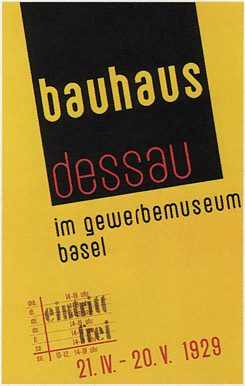 Bauhaus-Poster from 1929
| Photo: © picture alliance/Heritage images
Corporate identity was a thing even back during the Bauhaus era. Its idealistic pursuit of minimalism and efficiency extended beyond everyday objects and flats to typography as well. In 1925 Herbert Bayer, the young master of the print and advertising workshop in Dessau, suggested doing away with capital letters to improve time management. Now the Bauhaus letterhead read: “we write everything in lowercase because it saves time. and besides, why 2 alphabets when it amounts to the same thing? why write in uppercase when you can’t speak in uppercase?” This conscious disregard for the standard German spelling rules, where nouns are always capitalized, was seen as a sign of modernity. This bold step would have political consequences however, when city councils began simply destroying letters addressed to “Bauhaus from Dessau” and written in all lowercase letters. Fear began to spread of the communist potential of these apparently political “Bauhausers”
Bauhaus-Poster from 1929
| Photo: © picture alliance/Heritage images
Corporate identity was a thing even back during the Bauhaus era. Its idealistic pursuit of minimalism and efficiency extended beyond everyday objects and flats to typography as well. In 1925 Herbert Bayer, the young master of the print and advertising workshop in Dessau, suggested doing away with capital letters to improve time management. Now the Bauhaus letterhead read: “we write everything in lowercase because it saves time. and besides, why 2 alphabets when it amounts to the same thing? why write in uppercase when you can’t speak in uppercase?” This conscious disregard for the standard German spelling rules, where nouns are always capitalized, was seen as a sign of modernity. This bold step would have political consequences however, when city councils began simply destroying letters addressed to “Bauhaus from Dessau” and written in all lowercase letters. Fear began to spread of the communist potential of these apparently political “Bauhausers”
Women in the Bauhaus
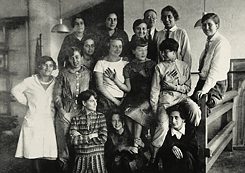 Group photo of Gunta Stölzl’s (in tie) weaving class from around 1927
| Photo: © picture alliance/akg-images
Gropius was surprised when just as many women expressed interest in attending his new art school as men. The art school admitted women, since the Weimar Republic’s new constitution granted women unlimited access to education, but they did not have an easy time of it there. Female students were fobbed off to the textile workshop whenever possible, and suffered ridicule from Bauhaus teachers, like mural master Oskar Schlemmer who said: “Where there is wool, you’ll find a weaving wench, be it to fill the idle hours at her bench.”
Group photo of Gunta Stölzl’s (in tie) weaving class from around 1927
| Photo: © picture alliance/akg-images
Gropius was surprised when just as many women expressed interest in attending his new art school as men. The art school admitted women, since the Weimar Republic’s new constitution granted women unlimited access to education, but they did not have an easy time of it there. Female students were fobbed off to the textile workshop whenever possible, and suffered ridicule from Bauhaus teachers, like mural master Oskar Schlemmer who said: “Where there is wool, you’ll find a weaving wench, be it to fill the idle hours at her bench.”
Wild fancy dress parties
It would be a mistake to imagine the Bauhaus as a hoard of serious avant-garde artists mulling over geometric shapes and abstract formulas all day. The Bauhaus’ minimalist and revolutionary design wasn’t the only way the movement was making waves. The Bauhaus hosted equally legendary and often themed costume parties and evenings of theatre and dance. The elaborate costumes and wigs represented weeks of hard work, and a great deal of effort went into learning new dance steps. Pieces like the Figurale Kabinett (the Figural Cabinet), a parody of progress and technology, or the Triadische Ballett (Triadic Ballet), a grotesque mix of dance, acting and pantomime, were performed on stage. The austerity embodied in the Bauhaus style was just one aspect of life in Weimar, Dessau and Berlin, after all.
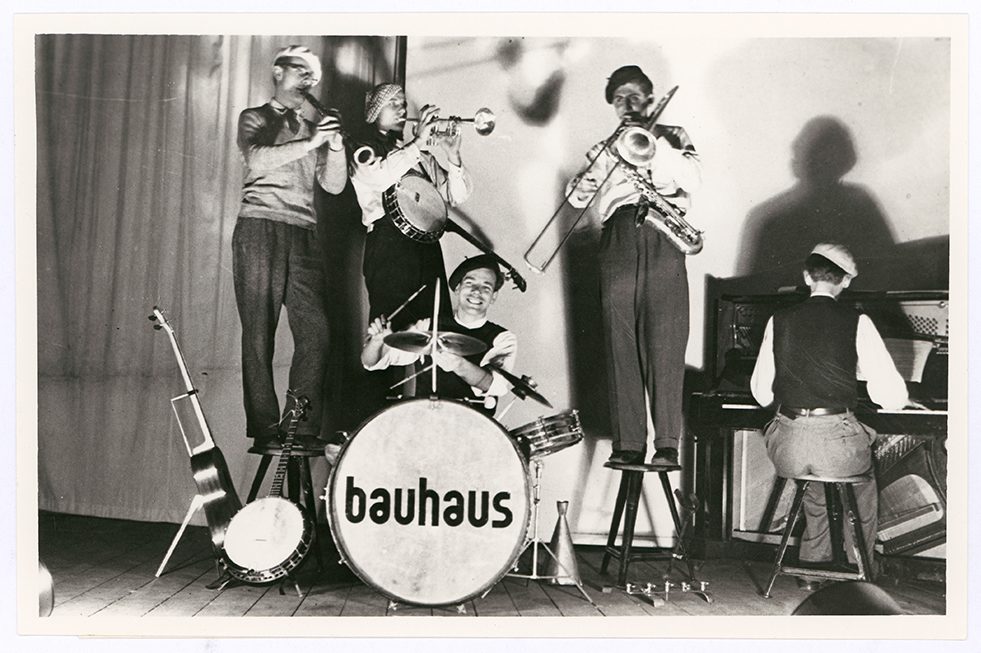 Performers of the Bauhaus band, 1930
| Photo: © Bauhaus Archiv Berlin
Performers of the Bauhaus band, 1930
| Photo: © Bauhaus Archiv Berlin
Ridicule
Bauhaus adherents didn’t have to wait long to be mocked for their unusual ideas and breaks with tradition. Philosopher Theodor W. Adorno dismissed the flat-roofed buildings as “tin cans”, while Dutch painter Theo van Doesburg poked fun at Bauhaus designs, calling them “expressionist fruit preserves”, and philosopher Ernst Bloch deemed the artwork “soulless”. But perhaps this type of vitriol simply goes hand and hand with success.
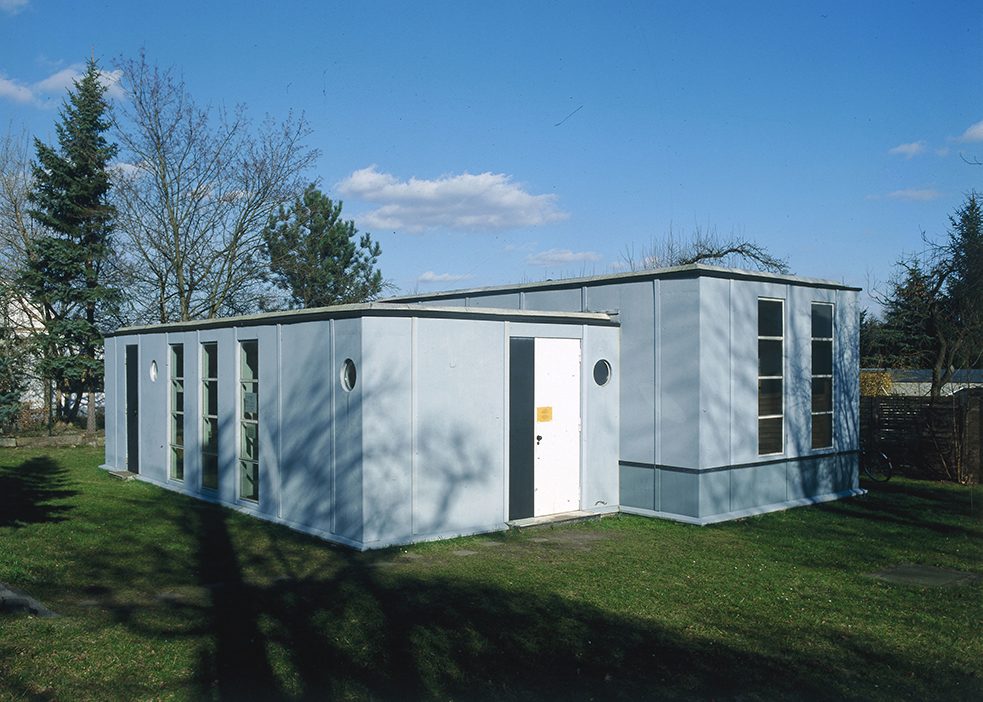 Flat-roof building, built 1926/27, in the Dessau-Törten Bauhaus housing estate
| Photo: © picture-alliance/akg
Flat-roof building, built 1926/27, in the Dessau-Törten Bauhaus housing estate
| Photo: © picture-alliance/akg
Cult disciples in the Bauhaus
In 1919, painter and educational reformist Johannes Itten came to teach at the Bauhaus, where he donned the cloak of a slightly esoteric Zen master. Deeply revered by his students, and thoroughly despised by his opponents, Itten brought the teachings of the Mazdaznan sect to the Bauhaus. The sect practiced vegetarianism, fasting, unique breathing exercises and a special form of sexual discipline. Itten’s teaching methods would prove controversial as well: gymnastic and breathing exercises were the order of the day, as were the master’s temperamental fits of rage when students didn’t follow his instructions to the letter. After a blowout with Gropius, Itten left the Bauhaus in 1923, and here too master Schlemmer furnished a scathing remark: “Meditation and rites were more important to Itten and his circle than work.”
Comments
Comment